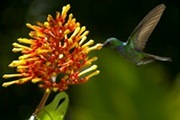Nature-lover and filmmaker Louie Schwartzberg directed Disneynature’s latest documentary The Wings of Life, an in-depth look at the relationship between birds, bats, bees and flowers – all told from the flower’s perspective! Find out more in our Kidzworld Q&A with Louie Schwartzberg.
 Louie Schwartzberg has been shooting flowers for 35 years
Louie Schwartzberg has been shooting flowers for 35 years
KW: When and how did you first become interested in nature and making nature documentaries?
- Louie: I became passionate about nature filmmaking when I graduated from UCLA, and one of the things I always wanted to do was shoot really high quality film, so I got into time-lapse photography - so that means when you shoot a flower you’re shooting like one frame every twenty minutes so that’s basically two seconds of a film per day. I’ve been doing that nonstop for 35 years, 24 hours a day, 7 days a week! I have a studio where I’m constantly shooting flowers.
KW: How did you come up with the concept for the film?
- Louie: When I heard that the bees were in trouble, the fact that they’re disappearing and not coming back to the hive, which is a big issue since a third of the food we eat comes from plants, I figured you couldn’t tell the story of the bees without the story of the flowers and how they basically have evolved together for over 150 years. That’s what motivated me to get the film off the ground.
 Bees help flowers spread pollenCourtesy of Disneynature
Bees help flowers spread pollenCourtesy of Disneynature
KW: What was the most memorable part of filming for you?
- Louie: I would say the most amazing experience for me as was being with the monarchs up in Mexico, where we were surrounded by millions and millions of butterflies, they’re just flying all around your head, it’s an incredible experience. It’s just like being in fall foliage with everything alive and flying around you and the sound of the wings and the way they cascade off the trees was almost like being in heaven.
KW: Was that also your favorite scene in the movie?
- Louie: I wouldn’t say it’s my most favourite, but when you watch the film I love the slow motion film of the bats at night which was the opposite experience filiming - its four or five or six all-nighters in a row and nothing is happening and you're wondering if you’ll ever get the shot – you're exhausted, tired, grumpy - but on screen I think they equal the butterfly sequences in terms of being fantastic and magnificent.
 Monarch Butterflies in MexicoCourtesy of Disneynature
Monarch Butterflies in MexicoCourtesy of Disneynature
KW: What are you hoping viewers will take away from this film?
- Louie: I positioned the story from the point of view of the flowers and I believe that beauty is a tool for survival in nature, that it’ll protect, and that’s what I’m hoping viewers and specifically kids will get, by falling in love with this amazing relationship. The colors and the beauty is sort of nature’s operating instructions that motivates all their behaviors, it’s not a superficial thing like what you might see in Vogue magazine and when you see this point of view it kind of opens your mind and once you see that it’ll make you want to protect it and create a more sustainable future.
KW: The scenery in the film is spectacular, where did you film and how long did it take?
- Louie: The filming took about a year and a half, and we were able to leverage a little bit the fact that I have this library of amazing time lapse flowers, but all the slow motion footage we had to film in places like Panama, Mexico - the humming birds, the butterflies, the bees in Arizona, and that took a tremendous amount of patience.
KW: Some of the footage from the movie seems almost impossible, are you sure you didn’t use CGI, it’s too spectacular to be true!
- Louie: Yes they are! We’re using really state of the art technology with the digital cameras to go super slow motion. The New York Times compared it to Life of Pi which won the academy award for best visual effect!
 Louie getting up close and personal with the flowersCourtesy of Disneynature
Louie getting up close and personal with the flowersCourtesy of Disneynature
KW: Do you have a new project started?
- Louie: I’m launching a web channel called so people can access my nature imagery and I’m working on another movie about mushrooms, because mushrooms create soil and they’re the foundation for plants. So I keep on diving into bigger and bigger ideas!
KW: What are some of your favorite nature documentaries?
- Louie: I would go back to the True Life Adventures that Disney did back in the ‘50s and ‘60s because I grew up in Brooklyn and as a kid I was never exposed to nature at all, and I remember the first shots of time lapse that I saw watching on a black and white TV screen. I think that had a big impact on my life. We wouldn’t play with nature, we played with popsicle sticks in the gutter. My parents were Holocaust survivors so they never really knew about nature, they were just happy to be home. You don’t have to be exposed to it as a child, nature can always touch your soul, even if you are exposed to it later in life. I want viewers to see that everything is connected, even the little guys, like pollinators and flowers.
Check out this clip from The Wings of Life below!
Have Your Say
Have you seen Wings of Life? What did you think? Let us know in the comments section below.

































